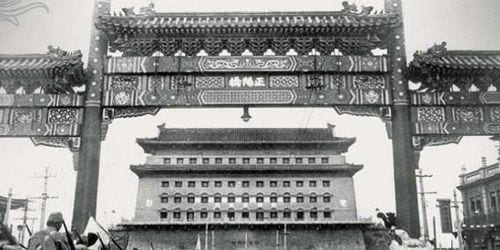
Peking, China, 1937 is a bloody mess. On the cusp of World War II and surrounded by nations with a vested interest in the country for reasons both political and military—Britain, Japan, Russia, Communists—the last thing Peking needed was the mutilated body of a foreign girl thrown out at the base of the city’s most recognizable landmark, The Fox Tower.
But that is exactly what happened; a proverbial match struck to a powder keg of a city.
The ensuing hunt for the killer responsible for the brutal, malicious death of Pamela Werner, a 19-year-old British schoolgirl residing in a foreign land with her professorial father, is the core of Paul French’s expertly crafted research and investigation into the nefarious details of this true crime.
Pamela and her father, E.T.C. Werner, are British citizens residing in Peking in a time of civil and political unrest. Living in the foreigners-only area of Peking, known as the Legation Quarter where “the great powers of Europe, America, and Japan had their embassies and consulates,” they are surrounded by a city that was the jewel of old China; rich, prized, and targeted by warlords. The Fox Tower, the city’s old watchtower erected in the 15th century, is where Pamela’s body is found on a frigid January morning, the morning after a celebration of Russian Christmas.
Locals believe The Fox Tower is haunted by fox spirits and are reasonably wary of its outwardly supernatural presence. And the mutilated body of a young foreign girl is enough to send rumors scattering through the city.
Chinese detectives, lead by Colonel Han, are quickly called in. And a British Detective Constable Inspector (DCI) Richard Dennis, is brought on as a powerless investigation aide by shadowy British figures with other concerns than solving the murder. What follows is a tight, pulse-setting tale of the bizarre and perverse including nudist colonies, political confusion, police misdirection, red herrings, Russian hermaphrodites, and a descent into the bacchanalian region of Peking known as the Badlands.
All the while, the city of Peking waits for the hammer to fall; for the next warlord to invade while the Fox Tower and its spirits loom silently above them. Or, as French skillfully states, “The city’s terror was coalescing and now there was a name to embody the horror that would befall them all—Pamela Werner.”
It’s unfair to the reader to divulge further details of the Werner case as recollected through French’s thrilling narrative. (I fear I may have revealed too much as it is.) Part of what makes Midnight In Peking so engrossing is French’s sharpened eye for procedural details, coupled with the ability to pare down contextual and situational descriptions to their bare minimum. What could have easily devolved into a convoluted juggling act of characters and history is streamlined into a brisk, exciting narrative.
Any story worth our time—even true crime—isn’t going to survive long without compelling characters and French devotes his prose to making certain we care about the death of Pamela Werner, even though it’s not a timely or revolutionary event. It’s simply a tragic event of the past cast through the lens of History that touches on our base sense of humanity; a father loses a child and looks for closure.
French captures Pamela, the book’s central figure, in a perfect state between adolescence and adulthood. She’s fierce and headstrong, a bit of a tomboy; yet, she has a string of suitors that are all eager to become part of her life—even for brief sexual moments. Unsurprisingly, this in-between state leads to confrontations with her stern, professorial father, a man who is equal parts protector and disciplinarian and who devotes the last years of his shattered life to solving the murder of his only child.
The pain from the tragedies—both his and hers—is alive and palpable on the pages, even though it’s nearly 100 years in the distance. French’s taunt, informal prose portrays the frustration and heaviness of a father forced to watch as detectives miss vital clues, the case closes, and bullheaded judges stymy his efforts to reopen the case, even in light of new evidence: “Peking had forgotten Pamela; the British Legation had forgotten Werner… Werner’s findings were a potential embarrassment to the British diplomats and officials in China, who’s worked so strenuously to close down his daughter’s case and discredit him. It was a pursuit into which they’d put far more effort than they ever did into solving the crime.”
French applies the same thoughtfulness into making the city of Peking it’s very own character: alive, mournful, and full of dichotomies. The bustling streets of Peking, full of stalls selling “everything from dried fruits and iced sweets to baked yams and rice-stuffed lotus roots”, fade into oblivion just a few streets over in The Badlands: “The ‘better’ class of foreigners thought the Badlands typified Chinese depravity; the Chinese thought it symbolic of barbarian foreign ways. Both mostly pretended it didn’t exist. They were fooling themselves.”
In the same manner, Peking is thrust into an unwanted storm of self-reflexivity and confrontation with its rotten core, so are we thrust into the world of Pamela Werner, her killers, and the surrounding bureaucrats assigned to her murder investigation. Unlike the residents of 1937 Peking, though, we are forced to confront the horrific details of Pamela’s murder through hindsight and, what’s more, to consider the implications of history’s strength when we see fit to bury it. French sheds a light on our pasts and comes up with a compelling thriller in the process.

![Call for Papers: All Things Reconsidered [MUSIC] May-August 2024](https://www.popmatters.com/wp-content/uploads/2024/04/all-things-reconsidered-call-music-may-2024-720x380.jpg)



